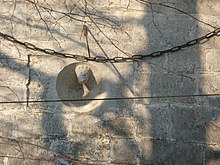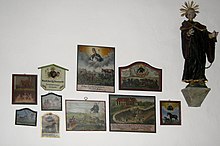St. Leonhard (Tholbath)
The " Chain Church " St. Leonhard is a branch church consecrated to Leonhard von Limoges , dating from the Romanesque period and a former pilgrimage church in Tholbath , a part of the municipality of Großmehring in the south-eastern district of Eichstätt in the Altmühltal Nature Park ( Bavaria ).
history
From time immemorial, Tholbath formed a branch of the parish of Theissing in the diocese of Regensburg , evidenced for 1559 . The sacred building of the village, the "chain church" St. Leonhard, is "one of the most interesting Romanesque buildings in the Ingolstadt area." It was consecrated by Eichstätt Bishop Otto between 1183 and 1195 and is seen as a remnant of a castle for the local nobility. The 95 stonemasons' marks , especially on the southeast side of the choir , suggest that the Regensburg Dombauhütte was involved in the construction and that around half of the stonemasons came from Italy .
Building description
The hall church made of regular limestone blocks has a retracted, semicircular choir with a semi-dome in the east. The round choir arch sits on Romanesque arch posts with limestone fighters. The nave is flat-roofed. Its floor plan is 8.5 by 6.5 meters on the outside and 6.5 by 4.5 meters on the inside, the wall height is six meters for the nave and five meters for the apse. The arched frieze carved from limestone on the outside of the choir rests on 15 differently designed human and animal heads. The cladding of the Romanesque choir window, the middle of originally three windows, is stepped three times with rows of hemispheres made of limestone.
The windows of the nave were broken out in the Baroque period (18th century). In contrast, narrow Romanesque windows were walled up.
The portal of the church is on the south side. It consists of two rows of columns with "misshapen" climbing animals (lions). In the arch of the portal vault, the animal figures and a man's head have been preserved, while only remnants of these figures can be seen on the sides of the portal. The tympanum consists of a relief that shows the teaching Christ with a book, flanked by two men also with books and therefore interpreted as evangelists . In the vertex bend of the walled Romanesque window above the portal is to see a bearded guard head. On the west side, in 1907, the church received a square tower with an octagon , crowned by a neo-baroque onion dome, as a replacement for a roof turret that was broken off in 1861 . The sacristy built on the northeast side was also removed in 1861 and replaced by a sacristy in the basement of the tower.
particularities
- The iron chain hung like a garland around the church at the height of the roof attachment is reminiscent of the centuries-old Leonhard pilgrimage. On Leonharditag (November 6th) a horse blessing took place here until 1940. Votive offerings, tinny horses hanging on this chain have disappeared today. It is not known when the chain was attached; the oldest drawing of the little church from 1844 shows it with a chain, a drawing from 1890 without a chain.
- A headless figure with a staff in his right hand is walled in on the west wall about five meters high, probably representing St. Leonhard or St. Laurentius is the former patron of the church .
- Above the portal is probably one of the oldest, but no longer fully preserved sundials in Germany.
- In the substructure of the tower, a tombstone of a Roman legionnaire on the march , which was previously walled in on the west side, is kept (with the left leg missing today).
- According to the Hague Convention of 1954, the church is included in the list of cultural property worthy of protection.
Furnishing
The altarpiece of the small, richly carved, four-pillar baroque altar (around 1760/70) built over an old stone block altar shows an oil painting with the church patron in monk's clothing in front of a monastery, probably the Scheyern monastery . The two flanking baroque wooden figures represent the Roman martyrs and weather patrons John and Paul. The procession poles in front of the choir show kneeling angels in choir clothing holding candlesticks (made of wood; around 1640/50). The church also contains a Madonna from the Baroque period and two Leonhard statues. The Way of the Cross was painted by an unknown hand in 1760/70. The ten votive tablets on the northern inner wall were dedicated to St. Leonhard offered as cattle patron; they were painted between 1838 and 1942. The wall cross above the entrance on the south wall dates from the last decade of the 18th century.
legend
The following legend is related to the origins of the church:
Two giants once lived in Tholbath and Weißendorf , each building a church. This led to a competition as to which church would finish first. When the Weißendorfer giant saw that the church in Tholbath was almost finished, he threw a stone at it. He missed her, however, and instead hit the other giant, who lost a leg as a result - hence the gravestone with the (apparently) one-legged man on it.
literature
- Gustav von Bezold and Berthold Riehl (editor): The art monuments of the Kingdom of Bavaria. The art monuments of the administrative region of Upper Bavaria. 1st part. City and district office Ingolstadt, district offices Pfaffenhofen, Schrobenhausen, Aichach, Friedberg, Dachau . Munich 1895, p. 90 f.
- Georg Dehio: Handbook of the German art monuments. Bayern IV: Munich and Upper Bavaria. Munich, Berlin 2006, p. 1265.
- Franz Dietheuer: The Romanesque church at Tholbath with its stonemason marks . In: Ingolstädter Heimatblätter (supplement to the Donaukurier), 22 (1959), p. 28 ff.
- Erich Mandel: 800 years St. Leonhardskirche Tholbath 1190 1990. Baldham [1990], 18 pages.
- The Eichstätter area past and present . Eichstätt: Sparkasse 1973, p. 156, 2nd edition 1984, p. 290 f.
- Peter Leuschner : Romanesque churches in Bavaria. Pfaffenhofen 1981, p. 11 f.
- Josef Reichart: From Romanesque churches in our area. The stone figure on the west side of the Tholbath Church. In: Collection sheet of the Histor. Ingolstadt Association 87 (1978), pp. 319–321.
- Johannes Hofmann : The side church St. Leonhard zu Tholbath. In: Churches of the parish of Theissing. Regensburg 2008, pp. [21] -28.
Individual evidence
- ^ Dehio, p. 1265
- ↑ Mandel, p. 9; Dehio, p. 1265
- ^ Mandel, p. 8
- ↑ Dehio, p. 1265; Churches of the parish of Theissing, pp. 23, 25
- ↑ Leuschner, p. 11
- ↑ Bezold / Riehl, p. 91
- ↑ Eichstätter Raum, p. 290; Mandel, pp. 4-11; Churches of the parish of Theißing, p. 21 f.
- ↑ Mandel, pp. 3, 7 f.
- ^ Mandel, pp. 6, 18
- ^ Reichart, p. 319
- ↑ Eichstätter Raum, p. 290; Almond p. 14
- ^ Churches of the parish of Theißing, p. 21 f.
- ↑ Mandel, pp. 15-17; Churches of the parish of Theissing, pp. 25, 27
- ↑ The churches in Tollbath and white village near Ingolstadt. on books.google.de
- ↑ Kurt Scheuerer: Legends from Ingolstadt and the region - The two giants of Tholbath and Weißendorf on www.ingolstadt.de
Web links
Coordinates: 48 ° 49 '20.2 " N , 11 ° 13' 34.1" E





